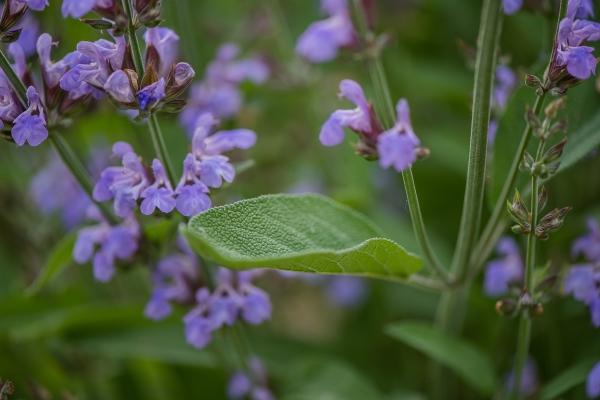
Featured Plant: Sage (Salvia officinalis)
I am SAGE and my story is SAFETY. I infused the honeyed wine of the Egyptians to honor Ra and celebrate the sun. I am sacred to Jupiter, sky god of the Romans, and I protect the weary traveler when she is far from home. I’ve been cultivated since the earliest times to prevent disease, heal the sick, and prolong life on earth.
I am here because issues of safety are manifesting in your life in an important way right now. The world is beautiful, but it is also dangerous, and all humans worry sometimes about the possibility of natural disasters, falling sick, losing someone they love, or other misfortunes. If apprehension and anxiety cloud your mind you must harness your thoughts. Avoid ruminating on things you cannot control.
Instead, create safety by taking reasonable action to protect yourself through appropriate insurance policies and medical coverage. Choose environments that are free of pervasive violence or threat and make choices to ensure your health and wellness. Cultivate relationships with people who allow you to be open and vulnerable, ask you to share your ideas, and give your spirit room to expand into its yearnings. Finally, add to the safety of your community by offering your respectful, supportive, and compassionate kindness to all that you encounter.
About Sage
Sage (Salvia officinalis) is an evergreen, perennial herb of the Lamiaceae (mint) family native to the Mediterranean, northern Africa, Spain, and the Balkans but cultivated around the world. This culinary herb is familiar to most cooks and grows to approximately 2 feet in height. Sage has a shrubby shape, woody stem, soft, silvery-green oval leaves, and a perfusion of deep blue or violet flowers that bloom in late spring.
The genus name, Salvia, comes from the Latin word salveo, a root meaning, “to save”, “safe”, and “be well”. The species name, officinalis is an epithet used when a plant has a well-established medicinal history. In fact, the world’s oldest pharmacopoeias list Saliva species as ingredients in medicines, in formulas to nourish the gods, and in magical elixirs to drive away evil spirits. In Mesopotamia, clay tablets inscribed with cuneiform script describe plant and mineral formulations for specific diseases and mention sage. The oldest of the Mesopotamian tablets from the famous library of Ashurbanipal, dates to 2200 BCE.
Dioscorides tells us that the Egyptians worshipped their sun god, Ra with herbs and resins mixed into honeyed wine. Archaeological samples of wine jugs from a tomb at Abydos indicate that sage, along with myrrh, lemon balm, cassia, coriander, mint, thyme, and juniper were the ingredients used to honor Ra. The samples are radiocarbon dated to 3150 BCE.
Steam distillation of the fresh or dried leaves and flowering tops of sage plants yields a pale yellow liquid with a fresh, herbaceous, spicy aroma with hints of camphor. Aromatherapists prefer Salvia officinalis grown and produced in France as chemical composition varies from country to country or because of late harvesting. The essential oil proves useful for the respiratory and muscular system, for oily skin care, for oral hygiene, and for conditions of the female reproductive system. The oil is always diluted, never used internally, and not applied in blends for older adults, children, or during pregnancy.
